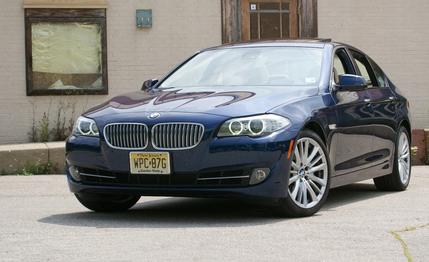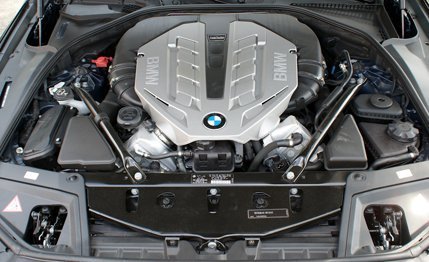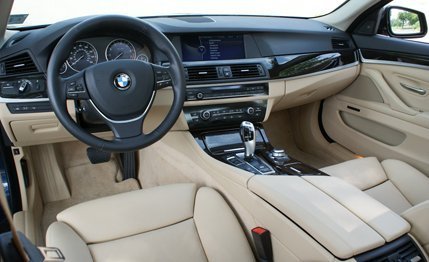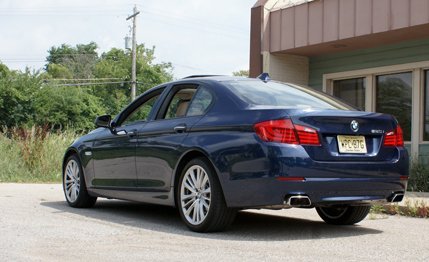
 Short Take Road Test
Short Take Road Test


Describing a BMW 5-series with rear-wheel drive and about 400 hp from a V-8 conjures a specific memory for most car enthusiasts: the legendary E39 M5. But since that model went out of production in 2003, BMW has armed itself to the teeth in the horsepower wars, and these specs now describe a run-of-the-mill 550i.
The 550i starts at $60,575 (with options, our automatic test car topped $75,000 and the manual neared $70,000, but more on that later), reaffirming its place as a car for the well-to-do. Even though it doesn’t offer the cavernous accommodations of the 7-series with which it shares some architecture, the 550i is in most other ways a smaller 7-series. And that’s no bad thing, especially if luxury is atop your priorities list.
Power comes from BMW’s twin-turbocharged, direct-injected 4.4-liter V-8, and delivery of the 400 hp and 450 lb-ft of torque is so smooth and quiet when hooked to the new ZF eight-speed automatic (a no-cost option) that you’ll need to have the radio off and your lead foot on to hear so much as a growl from the exhaust. The manual-equipped car, on the other hand, is not afraid to speak up, growing louder as you near redline.


At the test track, the autobox edged out the manual by 0.3 second in the sprint to 60 mph, at a mere 4.8 seconds—the manual’s wider gearing and trickiness at launch account for the difference—but it was a draw by the time they passed the quarter-mile, with both cars arriving in 13.1 seconds at a swift 109 mph. For comparison, the 2011 automatic trumped the significantly lighter last-gen 550i by 0.4 second to 60 mph, and it bests the current rear-drive 750i by the same amount.
There’s no way to describe the driving experience in this car without addressing the network of supercomputers, which are mostly part of options packages, and its implications. What this 550i does differently from the old is allow the driver to adjust suspension settings rather than be forced to accept a near-flawlessly calibrated balance of luxury and sport out of the box. When kitted as both our cars were, with the $2700 Dynamic Handling package and $2200 Sport package, the 550i experience can be tailored using the capo di tutti capi—or “boss of all bosses,” as the Italian mobsters used to say—a system called adaptive drive. It’s a set of preferences, controlled with center-console buttons or through the iDrive interface, for most of the car’s driving characteristics, from ride to throttle response to handling. Although the discerning driver (or hopeless tinkerer) can fine-tune these through iDrive, it’s easiest to leave the system in one of its four main settings: comfort, normal, sport, and sport plus.
The differences among the settings are mostly linear, with each setting sportier than the last, and they all do a fine job of managing the 550i. Thanks to active roll stabilization, the 550i remains more or less flat during vigorous cornering, but its weight gain of more than 300 pounds over the last 550i is undoubtedly felt. Yes, the new dynamic suspension does a good job of managing road scars—BMW touts that it can appropriately adjust rear-wheel damping in time to handle a pothole the front wheel has just hit—but it doesn’t deliver the wafty ride you might expect in a Lexus. And it’s not super at being sporty, either, being less sure-footed than the 3-series and exhibiting a little wheel shudder at the limit when road surfaces aren’t glassy.


The steering in the 550i is by far its greatest downfall. The electrically assisted system is linear, but it feels artificially heavy and is devoid of feedback, even when it’s supposedly been livened in the sport or sport-plus settings. Coming from BMW, this is a huge disappointment, and the steering of the 550i can’t hold a candle to the fine feel provided by the tiller in the Audi A6. At legal speeds, the steering in the 550i isn’t so lifeless as to be unforgivable, but it takes time to get used to. When pushing the car, though, we find that the lack of feedback leaves one guessing the precise amount of input needed to control the vehicle.
Between the dull steering and the easy-as-pie computerized handling, the 550i offers a fast journey but a driving experience that lacks the drama, involvement, and excitement we expect from BMW. We walked away from the manual 550i with a slightly better impression of the 2011 5-series, but it simply boiled down to feeling more connected to the car through the gearbox, something the automatic can’t deliver.
Inside the 550i’s cockpit, coddled by outstanding fit and finish, you’ll find creature comforts that would shame a luxury spa. The 18-way power seats included in the Sport package make a Herman Miller chair feel like a pile of cinder blocks and save you the shame of the standard 10-way thrones. We also enjoyed the head-up display ($1300) on both cars when we weren’t wearing polarized sunglasses—they cause the display to nearly disappear—and also dug the spy-like side- and top-view cameras ($800) fixed to our automatic test car.


The trick to avoiding these cars’ skyscraping as-tested prices of $75,100 and $69,575 is to choose your alphabet-soup options sparingly. Clearly, we’d opt for the manual transmission but would equip the cars identically otherwise, including the Sport pack. But skip the Driver Assistance package, which costs $1750 and adds computers that detect cars in your blind spot, look for stuff you could hit to the rear, and tell you when you’ve departed from your lane. The $1050 Cold Weather package, which heats the rear seats, the steering wheel, and the headlight washers, is unnecessary for most. And given our disdain for extra algorithms between us and the road, the $2700 Dynamic Handling package, which includes dynamic driving control and active roll stabilization, would be out, too. (LED headlights, dynamic brake control, dynamic stability control, and dynamic traction control are standard on the 550i.)
Option a 550i judiciously, and you’ll have a very fast, comfortable, luxurious sedan with some cachet. But all the associated controls and systems only serve to emphasize the stark difference between now—when BMW fits a bunch of computers that drive for you—and the days when a 400-horse 5-series needed only one letter to make its point: M. The 550i is a fine luxury car indeed, but the old BMW spirit isn’t on the options list.